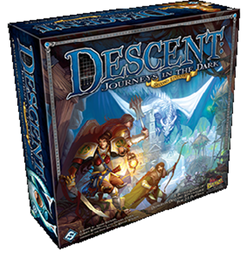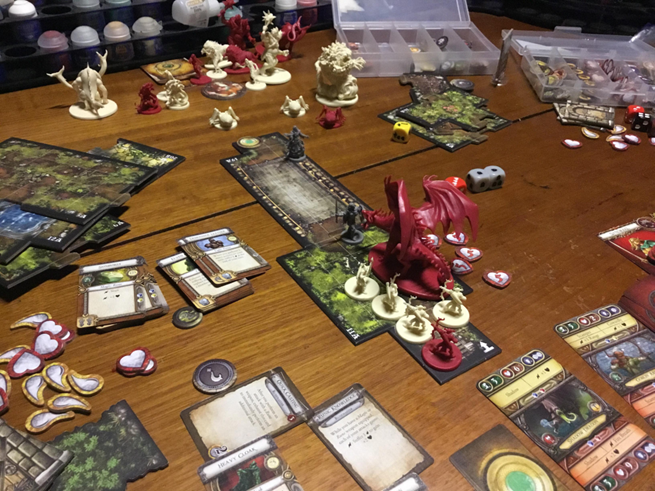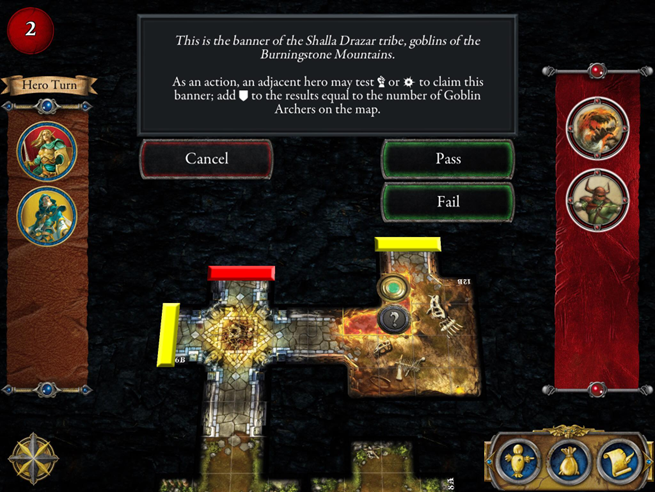 My main love is Dungeons & Dragons. It’s the game I return to again and again. However, I also play a lot of board games. Some of them are a tiny bit like D&D. Descent: Journeys in the Dark is one of those.
My main love is Dungeons & Dragons. It’s the game I return to again and again. However, I also play a lot of board games. Some of them are a tiny bit like D&D. Descent: Journeys in the Dark is one of those.
Descent suffers from being a game in a similar space to D&D: It requires a referee (Overlord) and players. The good thing about it is that you only need one player. In addition, because it’s a board game, there much less preparation required than with D&D: just open the box and go! The rules are relatively simple, although there are several exceptions to complicate things, and although there are individual scenarios that take 1-2 hour to play, you can also play in a campaign that lasts up to 20 hours or so (this you’re likely to play over several weeks). Most of the time, I’d rather play D&D, but there’s time when a fantasy adventure board game is the game I want to play.
I’ve been so involved in D&D that I missed that Fantasy Flight Games brought out an app – Descent: Road to Legend – that replaced the Overlord. So, instead of needing one player to control the monsters, up to four players can play the game together with some device (an ipad in my case) dealing with all the adventure and campaign details. Funnily enough, the reason I learnt about the app was because I saw the announcement that they’d just released an app for Imperial Assault! So, now I have both.
I’ve just played through the introductory campaign of Descent: Road to Legend. To play the game, you need the app (it’s free) and a copy of the board game (that’s significantly not free). It was an interesting experience. The app allows you to add material from the expansions, and incorporates into the game, but I played with just the base game. Two main scenarios and two side-quests later and I was finished. That last scenario? It took a while: 2-3 hours, though I may have been distracted while playing it. The other scenarios were significantly shorter.

The climax of a scenario!
The app played well. You, being human, need to make some decisions for it – the best place to move monsters, and occasionally which character to attack. It kept track of all the equipment, gold and XP I gained during the campaign, so I could pack things away between scenarios and then start again later if I wanted to.
The most frustrating thing about the game was it kept referring me to the “Road to Legend” rules, which are available as a separate pdf download. That’s nice, but I really wanted them to be incorporated into the app. On my iPad, switching between the pdf-reader and Road to Legend was annoying. I might end up printing the rules, but they’re very colourful and it would be a waste of ink.
 The app describes how scenario-specific features work.
The app describes how scenario-specific features work.
I took a party of two adventurers – a warrior and a wizard – into the introductory quest, where we faced Splig, King of All Goblins. It’s slightly whimsical, with Splig being chaotic and full of self-importance. It felt relentless. Monsters would continually spawn and attack, and there were times where we only just survived. The last scenario, in particular, was brutal, and I defeated it with no lives remaining, and with my adventurers down to their last few points of Health.
The game gives special bonuses to monsters seemingly at random, in addition to changing their tactics from round to round, which means that you’re never quite sure what they might do. Yes, goblin archers will tend to keep a safe distance and fire arrows, but not always! It keeps interest in the game.
 Monster Activations
Monster Activations
Now that I’ve finished the introductory campaign, I can start exploring the other options. There’s one other free campaign of greater length, another free campaign that requires you to own the Labyrinth of Ruin expansion, and two DLC adventures that can be purchased. The app is available for PC through Steam, and for mobile devices on iPad and Android.
Playing solitaire does mean I lose the social aspect, but at least I get it to the table – with three other players I’m more likely to play a strategic boardgame. My friends, who enjoy co-operative play greatly, will likely use it to turn Descent into a purely co-operative game and enjoy it more that way. It’s a different, more complex game than the Tomb of Annihilation board game, but it is a lot of fun.
